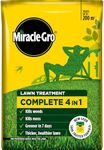Buying Guide for the Best Lawn Fertilizers
Choosing the right lawn fertilizer is essential for maintaining a healthy and vibrant lawn. Fertilizers provide the necessary nutrients that grass needs to grow strong and green. When selecting a fertilizer, it's important to understand the different types and their specific benefits. This guide will help you navigate the key specifications to consider when picking the best fertilizer for your lawn.N-P-K RatioThe N-P-K ratio represents the percentage of nitrogen (N), phosphorus (P), and potassium (K) in the fertilizer. Nitrogen promotes lush, green growth, phosphorus supports root development, and potassium enhances overall health and disease resistance. For a general-purpose lawn fertilizer, a balanced ratio like 10-10-10 is often recommended. If your lawn needs more green growth, look for a higher nitrogen content, such as 20-5-10. Understanding your lawn's specific needs will help you choose the right N-P-K ratio.
Type of FertilizerFertilizers come in various forms, including granular, liquid, and organic. Granular fertilizers are easy to apply and provide a slow release of nutrients over time. Liquid fertilizers offer quick absorption and immediate results but may require more frequent application. Organic fertilizers are made from natural sources and improve soil health while providing nutrients. Choose granular for ease and long-term feeding, liquid for quick fixes, and organic for environmentally friendly options.
Application MethodThe method of application can affect the effectiveness of the fertilizer. Granular fertilizers are typically spread using a broadcast spreader, ensuring even coverage. Liquid fertilizers can be applied using a hose-end sprayer or a watering can. Some fertilizers are designed for specific application methods, so it's important to choose one that matches your equipment and preferences. Consider your lawn size and the tools you have available when deciding on the application method.
Release RateFertilizers can be either quick-release or slow-release. Quick-release fertilizers provide immediate nutrients but may require more frequent applications. Slow-release fertilizers gradually release nutrients over time, reducing the need for frequent application and minimizing the risk of nutrient burn. If you prefer less maintenance, opt for slow-release fertilizers. For immediate results, quick-release fertilizers are a better choice.
Seasonal FertilizerDifferent fertilizers are formulated for specific seasons. Spring fertilizers typically have higher nitrogen content to promote growth after winter dormancy. Summer fertilizers focus on maintaining health during hot weather, while fall fertilizers prepare the lawn for winter with higher potassium content. Choose a fertilizer that matches the current season to ensure your lawn gets the appropriate nutrients at the right time.
Soil TestingConducting a soil test can provide valuable information about your lawn's nutrient needs. Soil tests measure pH levels and nutrient content, helping you choose a fertilizer that addresses any deficiencies. If your soil is lacking in certain nutrients, select a fertilizer that compensates for those specific needs. Soil testing ensures you are providing the right balance of nutrients for optimal lawn health.

















